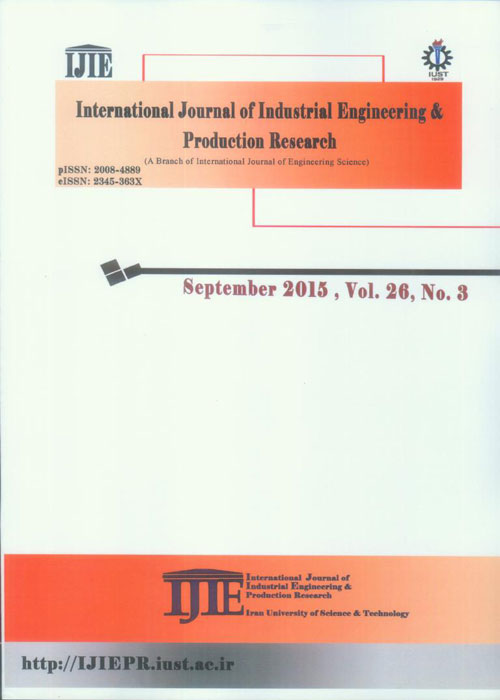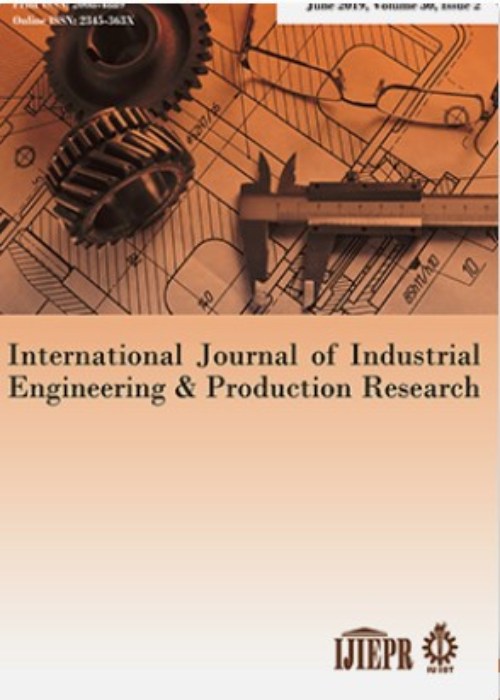فهرست مطالب

International Journal of Industrial Engineering and Productional Research
Volume:26 Issue: 3, Sep 2015
- تاریخ انتشار: 1394/08/30
- تعداد عناوین: 6
-
-
Pages 163-173Enterprise Resource Planning (ERP) has become the most strategic tool for an organization to employ. A leading ERP solution is SAP®. It has been employed by organizations to enable them to collaborate on different projects and to integrate all aspects of operations. Just as organizations have adopted ERP solutions, they employed quality initiatives that are designed to help organizations maximize efficiency. One of these quality initiatives organizations have turned to is Six Sigma. This paper explores the impact of SAP® solutions on the success of Six Sigma initiative implementation in an agile environment, where the needs of the customer changes rapidly. The literature shows that SAP® type ERP products play a critical role in the implementation process like Six Sigma, where the implementation process takes time. Also, the literature implies that in agile environments Six Sigma implementation can be ineffective.Keywords: Agile Management, Six Sigma, SAP
-
Pages 175-192Abstract One of the basic assumptions in hub covering problems is considering the covering radius as an exogenous parameter which cannot be controlled by the decision maker. Practically and in many real world cases with a negligible increase in costs, to increase the covering radii, it is possible to save the costs of establishing additional hub nodes. Change in problem parameters during the planning horizon is one of the key factors causing the results of theoretical models to be impractical in real world situations. To dissolve this problem in this paper a mathematical model for dynamic single allocation hub covering problem is proposed in which the covering radius of hub nodes is one of the decision variables. Also Due to NP-Hardness of the problem and huge computational time required to solve the problem optimally an effective genetic algorithm with dynamic operators is proposed afterwards. Computational results show the satisfying performance of the proposed genetic algorithm in achieving satisfactory results in a reasonable time. Keywords: hub location problem, dynamic hub covering problem, flexible covering radius, dynamic genetic algorithm.Keywords: hub location problem, dynamic hub covering problem, flexible covering radius, dynamic genetic algorithm
-
Pages 193-211In this paper an efficient three- stage algorithm is developed for software production cost and time estimation. First stage includes a hybrid model composed of COCOMO and Function Points methods to increase estimation accuracy. Second stage encompasses paired comparisons matrix of analytical hierarchy process to determine amount of any resources consumed in each step of software production by experts’ opinions. Third stage concludes cost and time tables of production scheduling by using Work break structure (WBS) and network models of project control. In whole of all stages of this paper, triangular fuzzy numbers are used to express uncertainty existed in succession and repetition of each production step, time of beginning, ending, the duration of each task and costs of them. Retrieved results examined by 30 practical projects conclude accuracy of 93 percent for time estimation and 92 percent for cost one. Also suggested algorithm is more accurate than COCOMOІІ 2000 algorithm as 50 percent based on examined problems.Keywords: software, cost, time estimation, fuzzy logic, network models, analytical hierarchy process
-
Pages 213-227Disasters can cause many casualties and considerable destruction mainly because of ineffective preventive measures, incomplete preparedness, and weak relief logistics systems. After catastrophic events happen, quick and effective response is of great importance, so as to having an efficient logistic plan for distributing needed relief commodities efficiently and fairly among affected people. In this paper, we propose a fuzzy multi-objective, multi-modal, multi-commodity logistic model in emergency response to disaster occurrence, to assign limited resources equitably to the infected regions in a way to minimize transfer costs of commodities as well as distribution centers activation costs, and maximizing satisfied demand. In the proposed model, we have determined the optimal place of distribution centers among candidate points to receive people donations as well as sending and receiving different kinds of relief commodities. The amount of voluntary donations is not known precisely and is estimated with uncertainty, so we have used fuzzy parameters for them. The number of victims immediately after disaster is vague and is estimated indecisively though we have considered it as a fuzzy demand. A case study has been displayed to test the properties of the optimization problem that shows efficiency of this formulation in experiment.Keywords: School of Industrial Engineering, Iran University of Science, Technology, Tehran, Iran
-
Pages 229-246This paper addresses a reliable facility location problem with considering facility capacity constraints. In reliable facility location problem some facilities may become unavailable from time to time. If a facility fails, its clients should refer to other facilities by paying the cost of retransfer to these facilities. Hence, the fail of facilities leads to disruptions in facility location decisions and this problem is an attempt to reducing the impact of these disruptions. In order to formulate the problem, a new mixed-integer nonlinear programming (MINLP) model with the objective of minimizing total investment and operational costs is presented. Due to complexity of MINLP model, two different heuristic procedures based on mathematical model are developed. Finally, the performance of the proposed heuristic methods is evaluated through executive numerical example. The numerical results show that the proposed heuristic methods are efficient and provide suitable solutions.Keywords: Facility failure, Heuristic algorithms, Reliable capacitated facility location, Uncertainty
-
Pages 247-257This paper offers an approach that could be useful for diverse types of layout problems or even area allocation problems. By this approach there is no need to large number of discrete variables and only by few continues variables large-scale layout problems could be solved in polynomial time. This is resulted from dividing area into discrete and continuous dimensions. Also defining decision variables as starting and finishing point of departments in area makes it possible to model layout problem so. This paper also provides new technique that models basic constraints of layout problems.Keywords: Location, Facility layout problem, Large, scale optimization, Mathematical programming, area allocation


